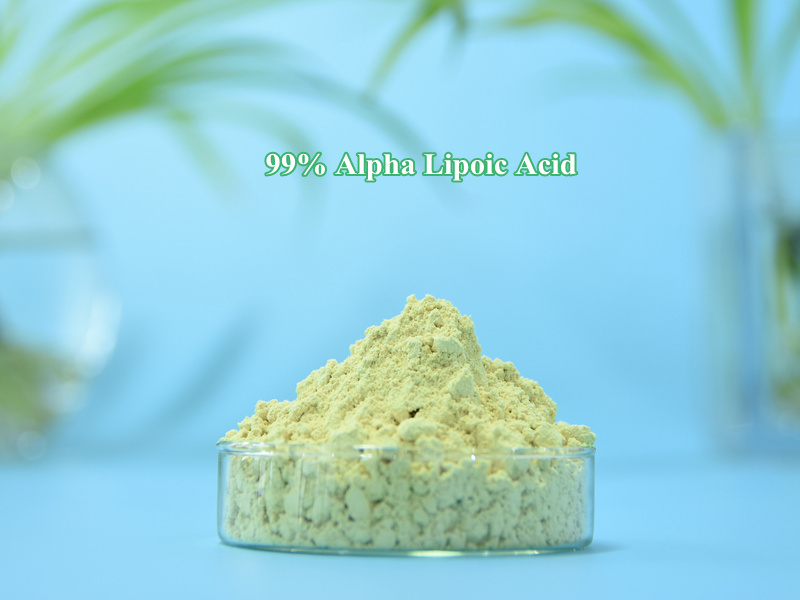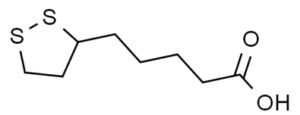1. α–Lipoic Acid Overview
α-Lipoic acid (LA) is a common cosmetic additive, known as “all-powerful antioxidant”. It has great antioxidant and anti-aging properties. But α-lipoic acid is slightly soluble in water and soluble in ethanol, ethyl and other organic solvents; it is more sensitive to light and oxygen, thus difficult to maintain its bioactivity. Plamed uses Nano Delivery System to develop α-lipoic acid, which makes it more effective and easily absorbed by skin.
α-Lipoic acid is a powerful antioxidant that can scavenge free radicals and reduce sun damage to skin. It can regenerate vitamin C to replenish the loss of vitamin C due to resistance to UV damage, so that the skin will restore smoothness and whiteness. Lipoic acid can also regenerate glutathione GSH, and prevent lipid peroxidation. In addition, studies have shown that LA can be used to treat pigmentation , such as freckles, melasma, and age spots. Importantly, α-lipoic acid is an effective cosmetic ingredient for anti-aging, anti-oxidation and skin whitening.

| Product Name | CAS Number | INCI Name | |
| α-Lipoic Acid | 1077-28-7 | THIOCTIC ACID | |
| Molecular Weight | Molecular Formula | Molecular Structure | |
| 206.3g/mol | C8H14O2S2 |  |
|
| Product ID | Specification | Minimal Package | Minimal Order Quantity |
| PMKZ1901 | 99% | 1KG | 1KG |
2. α–Lipoic Acid Source
α-Lipoic acid was first discovered in 1937 and isolated from pig liver in 1951. Earlier, it was only studied for its role as a coenzyme. It has been used in the clinical treatment of diabetic neuropathy in the 1960s. After that, especially since 1990, researchers have gradually discovered that LA has strong antioxidant capacity, the ability to chelate heavy metals, and the ability to regenerate other antioxidants. Since the mid-1990s, LA’s role in the prevention and treatment of aging-related diseases have attracted more and more attention.
3. α–Lipoic Acid Manufacturer Specifications
| Product Name | Specification | Color |
| α-Lipoic Acid | 99% | Yellow powder |
| Items | Specification |
| Assay | 99% |
| Appearance | Yellow powder |
| Physical Characteristics | |
| Particle Size | 98% through 80 mesh |
| Moisture | ≤1.00% |
| Ash Content | ≤1.00% |
| Heavy Metals | |
| Heavy metals | ≤10ppm |
| Arsenic | ≤1ppm |
| Lead | ≤1ppm |
| Microbiological Tests | |
| Total Plate count | ≤1000cfu/g |
| Yeast & mold | ≤100cfu/g |
| Escherichia coli | Negative |
| Staphylococcus | Negative |
| Salmonella | Negative |
4. α–Lipoic Acid Benefits
- Anti-oxidation & anti-aging
α-Lipoic acid can increase glutathione level in skin cells, and it can also “replace” it when other antioxidants are lacking. When the body lacks vitamin C or vitamin E, α-lipoic acid works and greatly enhances the role of vitamins as a powerful anti-oxidant. It can also strengthen the entire anti-oxidation network and quickly penetrate into skin. Dermatology clinical studies have confirmed that topically using α-lipoic acid can reduce the formation of fine lines on skin and protect skin cells from UV rays.
- Skin whitening
α-Lipoic acid can regenerate glutathione and increase the activity of glutathione-S-transferase, thereby generating a large amount of oxidized glutathione. Then it can be mutually converted with glutathione. Reduced glutathione can bind to the copper ion of tyrosinase to inhibit tyrosinase activity, thereby reducing melanin production.
5. Pharmacological Studies of α–Lipoic Acid and Cosmetics
| Test Item | Concentration | Result |
| Elimination of oxygen radical | The elimination ability was 1.08 times that of vitamin E with the same concentration. | |
| Promotion of hyaluronic acid production by fibroblast cell culture | 3×10-6 | Promotion rate: 126 (blank 100) |
| Inhibition of tyrosinase activity | IC50: 14.7μg/mL | |
| Promotion of the metabolic rate of the stratum corneum by patch test | 0.05% | Promotion rate: 11.8%
(Compare with control group) |
| Determination of the minimum amount of erythema by exposure to 40-200mJ/cm2 | 0.1mg/cm2 | Minimum amount: 135.6 (blank 100) |
| Promotion of hair growth in mice | 0.3% | Promotion rate: 110.6 (blank 100) |
6. Plamed α-Lipoic Acid Characteristic
- Plamed adopts Nano Delivery System(NDS), effectively solving the problem of unstability of α-lipoic acid.
- Plamed α-lipoic acidis cosmetics grade; it is suitable for cosmetic formula.
- Plamed α-lipoic acid significantly increases the skin absorption and bio-availability.
7. α–Lipoic Acid Application and Reference Dosage
α-Lipoic Acid is mainly applied in anti-oxidation and anti-aging skincare products, including facial mask, emulsion, serum, face cream, sunscreen, and other types of cosmetics.
| Product | Reference Dosage |
| α-Lipoic Acid | ≤5.0% |
α–Lipoic Acid uses tips:
- α-Lipoic acidcan combine with fatty acid in cosmetic formula.
α–Lipoic Acid application cases in major cosmetic brands in the world
| Country | Brand | Product |
| China | PURID | Refreshing Luminous Serum |
| UMOUA | Isosmotic Tech Peptide Serum | |
| QuadHA | Skin Dynamic Youth Cream
Eye Energize Regenerating Cream |
|
| Japan | Dr. Ci: Labo | Aqua-Collage-Gel-Enrich Lift EX |
| Elixir | Superieur Lifting Night Cream | |
| Korea | RNW DER. | Blanc Shining Toner
Blanc Shining Emulsion |
| O HUI | Prime Advance Ampoule Serum | |
| America | Elizabeth Arden | Ceramide Lift and Firm Night Cream |
| Paula’s Choice | Resist Super Antioxidant Concentrate |
8. α–Lipoic Acid Reference Formula
Toner
| Ingredient | Content(%) | Ingredient | Content(%) |
| α–Lipoic Acid | 0.5 | Hydrogenated Coconut Fatty Glyderides | 1.5 |
| Polyethylene Glycol | 3.0 | Dimethicone | 3.0 |
| Phenethyl Dimethicone | 2.0 | Cyclomethicone | 1.0 |
| Cetearyl Octanoate | 5.0 | Avocado Oil | 1.0 |
| Sweet Almond Oil | 2.0 | Wheatgerm Oil | 0.8 |
| Panthenol | 1.0 | Phytantriol | 0.2 |
| Tocopheryl Acetate | 0.3 | Propylene Glycol | 5.0 |
| Perfume | q.s | Preservatives | q.s |
| Water | Add to 100 |
Sun-care Oil
| Ingredient | Content(%) | Ingredient | Content(%) |
| α–Lipoic Acid | 1.0 | Cetearyl Octanoate | 40.0 |
| Capric Triglycerides | 28.7 | Evening Primrose Oil | 3.0 |
| Macadamia Nut Oil | 5.0 | Isopropyl Palmitate | 5.0 |
| Dimeticone | 3.0 | Octyl Methoxycinnamate | 8.0 |
| Octocrylene | 5.0 | 3-Benzophenone | 2.0 |
| Phytantriol | 0.1 | Tocopheryl Acetate | 0.2 |
| Perfume | q.s |
9. α–Lipoic Acid Safety
- Cosmetic, Toiletry &Fragrance Association (CTFA) has specified THIOCTIC ACIDas a cosmetics ingredient.
- THIOCTIC ACIDis included in The International Catalogue of Chinese Cosmetic Raw Materials Standards in 2010 issued by CAFFCI
- THIOCTIC ACIDis listed On the Announcement of Name List of Cosmetics Raw Material published by CFDA in 2015. No reports show its insecurity.
- The Ministry of Health, Labour and Welfare of Japan specifiesthat THIOCTIC ACID is used as a cosmetic ingredient with the highest limit.
10. Packing and Storage
Package: Packed in 25kg paper drums with two plastic bags inside.
Storage: Stored in a cool dry place and away from direct sunlight and oxidizing agents.

Plamed focuses on natural cosmetic ingredients for more than 10 years. We have founded four subsidiary companies, which respectively develops different kinds of cosmetic raw material. Plamed is a company whose CEO is designated as the first secretary general of Shaanxi Plant Extraction Association.
As a professional α-Lipoic Acid manufacturer, Plamed have been constantly upgrading the production process. We firmly believe that good α-Lipoic Acid and good α-Lipoic Acid price will help customers make good terminal products and help customers win a lasting and broad market.













